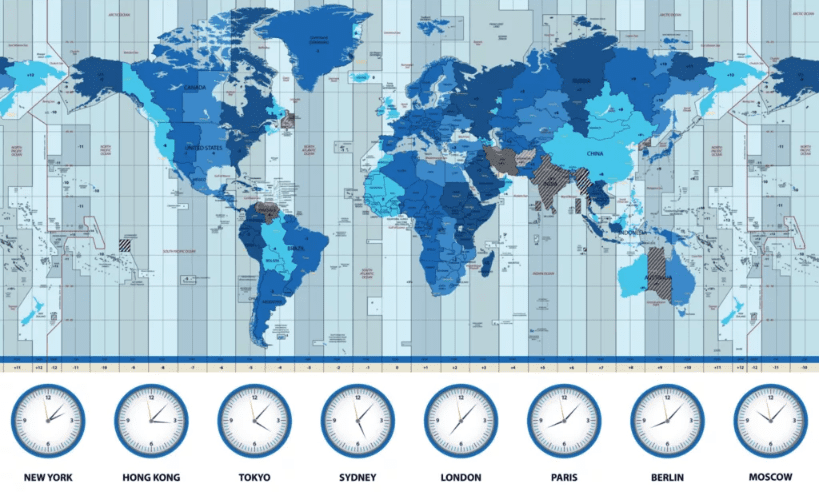Offshore time zone differences
The 1st step for you and your offshore team is determining the hours when both groups are accessible. For example, suppose you are operating from your office in Berlin, Germany, and your remote team is positioned in Vietnam, having a time zone difference of 5 hours. In that case, you can identify 3 hours of overlapping availability within the typical 9-to-5 work schedule. This time can be optimally utilized by conducting daily meetings to review advancements, address potential challenges, provide explanations, exchange feedback, and more.

Managing the time zone disparity during software development offshoring demands careful preparation. To address this, using a collaborative calendar platform like Google Calendar, where every team member enrols and provides regular updates, proves advantageous.
However, it’s important to exercise moderation, as maintaining high productivity remains the foremost objective in offshoring. Excessive communication could potentially impede the developers’ workflow. Instead, a suitable approach involves conducting regular calls on a daily or weekly basis involving managers and a select few engineers.
How to Deal with Time Zone Differences When Outsourcing to Vietnam
1. Be Mindful of Time
Recognize the existence of considerable time zone variations between your company and your outsourcing team in Vietnam. Be attentive to the time-related expectations of the team’s productivity. Schedule meetings, conversations, and project coordination at times that suit not only your convenience but also the convenience of the staff.
2. Precisely Specify Requirements
When defining requirements, aim for thoroughness to minimize the necessity for further clarification. This doesn’t go well with the waterfall methodology. Instead, Agile practices assist in swiftly outlining user stories while avoiding excessive upfront analysis.

Product owners must prioritize the quality of user stories. An effective user story should grant developers the requisite autonomy, including elements like visual mockups, user scenarios, frequently asked questions (FAQs), and more. By incorporating such elements, the offshoring process can advance seamlessly and efficiently.
Read more: Offshore Development Center that transforms your business: Where to find?
3. Be Attentive to Holidays
Although it might seem evident, organizations outsourcing with teams across varying Time Zones should uphold a publicly accessible compilation of local holidays for each relevant country.
For managing teams affected by Time Zone Disparities, companies need to maintain a list of local holidays applicable to each country involved. This empowers teams to strategize vacations, meetings, and time off while considering their capacity. Often underestimated, this aspect can give rise to unforeseen challenges.
4. Avoid Micromanagement
In Distinct Time Zones cases, the client must let go of the urge to oversee every tiny detail of the project and instead have confidence in the offshore team. Enlist a proficient team of experts and entrust them with decision-making and project management responsibilities.
5. Employ Communication and Management Tools
Implement digital platforms for communication and organization
When faced with Time Zone Discrepancies, it is vital for teams to establish user-friendly online spaces for exchanging information. Several interactive whiteboard choices, like Jamboard and Microsoft Whiteboard, offer effective means of collaboration. Additionally, having an internet-based document storage system, such as Google Drive or Atlassian Confluence, is important.
![]()
Teams can improve cooperation by leaving remarks and annotations within their working documents. This facilitates real-time and non-simultaneous editing of documents and diagrams, thus diminishing reliance on external communication avenues like emails.
Formulate and reach an agreement on a digital calendar app
Prominent technology firms and emerging startups provide digital calendar solutions tailored to accommodate time zone disparities. Microsoft Outlook, Google Calendar, etc, are just a few instances where platforms enable teams to arrange online meetings to deal with differences in time zones.
Employing appropriate tools simplifies identifying time slots where everyone is accessible. Web and mobile apps give prior notifications to participants about scheduled meetings while facilitating online conversations through platforms like Google Meet or Zoom.
Customizing a fitting profile on Slack or another digital chat platform is important for efficient online coordination. Integrating time zone information and availability within the profile helps smoothen coordination efforts.
Exercise caution in utilizing online meetings
Effective communication does not require a series of meetings. Conversely, burdening an offshore team with incessant meetings is considered undesirable.
Teams should define which topics and ceremonies necessitate online meetings and which can be handled via chat or email. For instance, they might use Slack for daily progress updates and troubleshooting discussions while conducting virtual sprint demonstrations. It is important to establish the purpose and frequency of meetings at the start of the project.
6. Offer Visual Aids for Time Zone Disparities
Establish Time Zone Guidelines

Organizations should define certain time zone norms before collaborating with offshore teams in Vietnam. This can involve designating whose local time will be taken as the standard reference, enabling the scheduling of meetings and setting deadlines accordingly. To alleviate any concerns, the recommended approach considers the offshore team’s local time as the standard.
Make some time zone visualizations available online
A time zone difference of two hours creates a scenario where one team commences their workday at 9 a.m., while the other team is either just beginning their day or having breakfast at 7 a.m. By day’s end, when the first team concludes their work around 6 p.m. (depending on the location), their counterparts still have a remaining two-hour span.
Due to this Time Zone Discrepancy, the overlap in their working hours diminishes. Instead of having a 9-hour window (spanning from 9 a.m. to 6 p.m.), these teams can collaborate in real-time for 7 hours. In the case of a 5-hour time difference, the collaborative timeframe reduces to 4 hours.
To facilitate efficient coordination, it is essential to have a centralized platform, such as an online world clock utility, a Confluence page, or Google Sheets, where the team can conveniently visualize the distinct time periods available for online or asynchronous cooperation. This aids in streamlining planning efforts and ensuring effective communication despite the challenges posed by varying time zones.
CMC Global: A Leading Offshore Development Company in Vietnam
As a prominent partner for offshore software development, our CMC Global team based in Vietnam includes over 2500 skilled professionals specializing in software and technology. Throughout our journey, we have successfully assisted over 350 global clients in realizing their ideal software products. Our offerings include various services, including product creation, testing, software evaluations, DevOps, and beyond.
Interested in discovering how CMC Global can contribute to your upcoming software development endeavor? Contact us today for more information.





